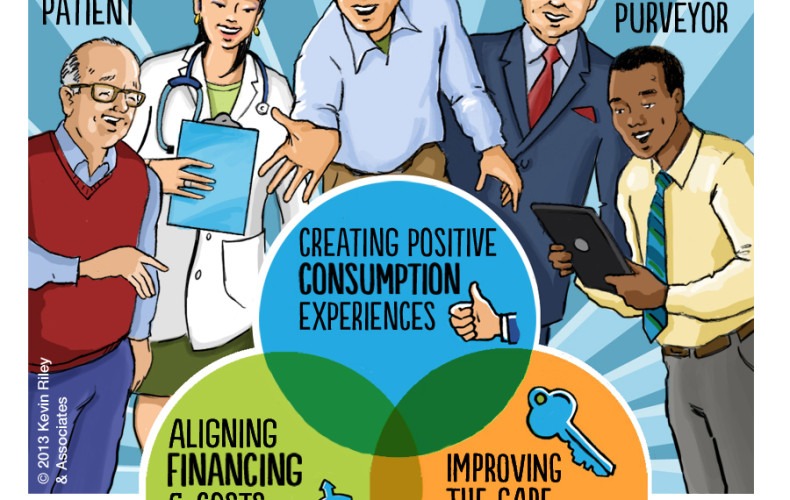Healthcare Innovation Require Three Things
For well over the past decade I have made innovative healthcare companies my home. In that time, I have developed a simple litmus test to determine if the company I am working with is ready, willing, and able to create breakthrough innovation. Let’s call it my “3-legged Stool of Innovation Readiness.” Like any three- legged stool, it cannot stand on only one or two legs – it takes all three.
An externality creating an impetus (Ready)
I have heard that only wet babies like change. While I am sure the part about the babies is true, I am not convinced that most companies are truly resistant to change. The inherent desire is there, which we will talk about next, but without some external force applying pressure, most companies will forgo change to focus on the problems of the here and now. I think of this as needing equal parts carrot (desire) and stick (impetus). However, very few companies are disciplined enough to apply their own stick. Ingredient number one of the three-legged stool is that impetus.
Look at the healthcare industry as an example. With the exception of those services rendered to consumers for direct cash payment (such as Lasik and liposuction), we have seen little change in quality or cost. In fact, many trends seem to point in the opposite direction. Now this is obviously not the entire fault of the healthcare industry – I have always argued that consumers are equally culpable. However like those folks that would rather eat potato chips and sit on the couch instead of getting out and exercising, companies do not often seek out a change in lifestyle – even when, change is necessary.
So along comes some outside force to require that change – The Affordable Care Act. Say what you will about its inability to address the underlying cost issues; Reform has forced the hand of the healthcare industry to do something about the problems at hand. And now that we are past the point of no return, these companies must act or potentially cease to exist.
Without PPACA, I am convinced there would be little or no room for disruptive innovators like myself within the “healthcare industrial complex”. As it turns out, we are now in high demand.
But even with the requirement to change, some companies are not willing to change. Many say they are but are merely paying lip service to that fact. Let’s talk more about that notion.
A real desire to change (Willing)
So the second ingredient is a deep desire or a sincere willingness to embrace change.
I have heard that addicts will not change their lifestyle until they hit bottom and bounce. I am not sure it is that drastic for healthcare companies. But obviously, a company must be willing to make room for new thinking and new thinkers before it can change.
Let’s take a lesson from science here. Consider that adding any catalyst to a mixture creates some reaction. However, most catalysts get used up in the reaction. If you are being asked to both implement a new disruptive idea and create a culture of change readiness (where none exists) at the same time – be forewarned. What I have found is that you do not want to be the straw that breaks the camel’s proverbial back.
What I mean by this is that to realize large-scale sustained change within a large company, you need an established platform for change in place. Staring from a cold stop requires all of your energy to just get the ball rolling, and leaves you no time or resources to implement your new ideas. So, if you find yourself in this scenario, ask yourself if you are primarily a “change agent” or an “innovator.” A change agent is willing to focus on creating the infrastructure required to sustain change and introduce new ideas –which may or may not be their own. This is noble work and requires a full commitment to the long-term culture of the company that one is changing. An innovator, as described in this discussion, is about creating new value and getting new ideas to market fast.
So, if you are primarily an innovator and you are focused on getting your idea to market quickly, without having the luxury of a change platform in place – you will likely meet roadblock after roadblock. And you will become frustrated. And you will want to quit or be asked to as you gain the reputation for not being able to “get anything done.”
So this cautionary tale is for both you the employee and for you the employer. To the employer, I recommend investing time and energy in facilitating change readiness so that you can bring change agents in and they will have success. For you the employee – make sure you know who you are and which role you are being asked to play. This will ensure your happiness and their success.
A means to invest in the future (Able)
So the final ingredient is the hardest to come by – ability. Even with the previous two (assuming they are ready and willing) – a company must be able to change. They must be financially stable enough to commit resources in the form of capital and talent directly to unknown or uncertain outcomes. For a company struggling to stay afloat, or concerned with the cost of upgrading their core “plumbing”, this can be a frightening and unrealistic necessity.
So know the environment you are going into and the one that you are in. If your company is not willing to dedicate at least 1% of their capability budget to innovation/R&D, then you will forever be chasing ideas and never implementing them. Great leaders like AJ Lafley from Procter & Gamble understood the need to invest in radical ideas. Ask your leadership if they are willing to “put their money where their mouth is” – with no strings attached.
A quick note of caution in this respect – if you are promised a budget based on other conditions (like finding savings elsewhere) – you are most likely not going to get it. We all know that overruns and unforeseen circumstances or priorities are common occurrences, and if you budget is relying on the efficiency and generosity of another group – be prepared.
A Final Note
When you find all three of these ingredients in a company – jump on the opportunity. My coming to Florida Blue (the Blue Cross Blue Shield Plan of Florida) in January of 2010 to be their Chief Innovation Officer, was predicated on their alignment with these three requirements for “breakthrough innovation.” As such, we were able to accomplish some amazing things and be counted among leaders in the healthcare payer space in innovation.
And if you are lucky enough to find all three ingredients, it is your job as an innovator and/or change agent to respect and nurture them within the organization. Ensure that you continually and effectively lead the clarion call for the importance and progress of your work. Congratulate your peers and leadership for their commitment to innovation, and remind them of their professional responsibility to advocate for, and push change in your company. Most importantly share in the victories you have created with and because of their sacrifices.
To your health
The Team at imagine.GO

















